Correlation Dimension in Sumatra Island Based on Active Fault, Earthquake Data, and Estimated Horizontal Crustal Strain to Evaluate Seismic Hazard Functions (SHF)
Abstract
1. Introduction
2. Data and Methods
2.1. Earthquake Frequency-Magnitude Distribution (FMD)
2.2. Correlation Dimension (Dc) of Earthquake and Active Fault Data
2.3. Seismicity Smoothing
2.4. Active Fault Modeling
2.5. Geodetic Modeling
2.6. Seismicity Rate Model: Earthquake Rate Formulation
2.7. Seismic Hazard Function (SHF) Estimation: Ground Motion Prediction Equation (GMPE) and Probability Exceedance (PE)
3. Result and Discussion
4. Conclusions
Supplementary Materials
Author Contributions
Funding
Institutional Review Board Statement
Informed Consent Statement
Data Availability Statement
Acknowledgments
Conflicts of Interest
References
- Fitch, T.J. Plate convergence, transcurrent faults, and internal deformation adjacent to southeast Asia and the western Pacific. J. Geophys. Res. 1972, 77, 4432–4460. [Google Scholar] [CrossRef]
- Prawirodirdjo, L.; McCaffrey, R.; Chadwell, C.D.; Bock, Y.; Subarya, C. Geodetic observations of an earthquake cycle at the Sumatra subduction zone: Role of interseismic strain segmentation. J. Geophys. Res. Solid Earth 2010, 115, B03414. [Google Scholar] [CrossRef]
- Sieh, K.; Natawidjaja, D.H. Neotectonics of the Sumatran fault, Indonesia. J. Geophys. Res. 2000, 105, 28295–28326. [Google Scholar] [CrossRef]
- Genrich, J.F.; Bock, Y.; McCaffrey, R.; Prawirodirdjo, L.; Stevens, C.W.; Puntodewo, S.S.O. Distribution of slip at the northern Sumatran fault system. J. Geophys. Res. 2000, 105, 28327–28341. [Google Scholar] [CrossRef]
- McCaffrey, R. Slip vectors and stretching of the Sumatran forearc. Geology 1991, 19, 881–884. [Google Scholar] [CrossRef]
- Bradley, K.E.; Feng, L.; Hill, E.M.; Natawidjaja, D.H.; Sieh, K. Implications of the diffuse deformation of the Indian Ocean lithosphere for slip partitioning of oblique plate convergence in Sumatra. J Geophys. Res. Solid Earth 2017, 122, 572–591. [Google Scholar] [CrossRef]
- Natawidjaja, D.H.; Triyoso, W. The Sumatran fault zone—From source to hazard. J. Earthq. Tsunami 2007, 1, 21–47. [Google Scholar] [CrossRef]
- Natawidjaja, D.H. Updating active fault maps and slip rates along the Sumatran Fault Zone, Indonesia. IOP. Conf. Ser. Earth Environ. Sci. 2018, 118, 012001. [Google Scholar] [CrossRef]
- Tim Pusat Studi Gempa Nasional-2017 (The 2017 PuSGen). Peta Sumber dan Bahaya Gempa Indonesia Tahun 2017; Kementrian Pekerjaan Umum dan Perumahan Rakyat: Jakarta, Indonesia, 2017. (In Indonesian) [Google Scholar]
- McCloskey, J.T.; Nalbant, S.S.; Steacy, S. Earthquake risk from co-seismic stress. Nature 2005, 434, 291. [Google Scholar] [CrossRef]
- Qiu, Q.; Chan, C.-H. Coulomb stress perturbation after great earthquakes in the Sumatran subduction zone: Potential impacts in the surrounding region. J. Southeast Asian Earth Sci. 2019, 180, 103869. [Google Scholar] [CrossRef]
- Cattin, R.; Chamot-Rooke, N.; Pubellier, M.; Rabaute, A.; Delescluse, M.; Vigny, C.; Fleitout, L.; Dubernet, P. Stress change and effective friction coefficient along the Sumatra-Andaman-Sagaing fault system after the 26 December 2004 (Mw= 9.2) and the 28 March 2005 (Mw= 8.7) earthquakes. Geochem. Geophys. Geosystems 2009, 10, 1–22. [Google Scholar] [CrossRef]
- Visini, F.; Valentini, A.; Chartier, T.; Scotti, O.; Pace, B. Computational Tools for Relaxing the Fault Segmentation in Probabilistic Seismic Hazard Modelling in Complex Fault Systems. Pure Appl. Geophys. 2019, 177, 1855–1877. [Google Scholar] [CrossRef]
- Swan, F.H.; Schwartz, D.P.; Cluff, L.S. Recurrence of moderate to large magnitude earthquakes produced by surface faulting on the Wasatch Fault Zone, Utah. Bull. Seismol. Soc. Am. 1980, 70, 1431–1462. [Google Scholar]
- Schwartz, D.P.; Coppersmith, K.J. Fault behavior and characteristic earthquakes: Examples from the Wasatch and San Andreas Fault Zones. J. Geophys. Res. Earth Surf. 1984, 89, 5681–5698. [Google Scholar] [CrossRef]
- King, G.; Nabelek, J. Role of fault bends in the initiation and termination of earthquake rupture. Science 1985, 228, 984–987. [Google Scholar] [CrossRef] [PubMed]
- Meng, L.; Ampuero, J.P.; Stock, J.; Duputel, Z.; Luo, Y.; Tsai, V.C. Earthquake in a Maze: Compressional Rupture Branching During the 2012 Mw 8.6 Sumatra Earthquake. Science 2012, 337, 724–726. [Google Scholar] [CrossRef]
- Field, E.H.; Dawson, T.E.; Felzer, K.R.; Frankel, A.D.; Gupta, V.; Jordan, T.H.; Parsons, T.; Petersen, M.D.; Stein, R.S.; Weldon, R.J.; et al. Uniform California Earthquake Rupture Forecast, Version 2 (UCERF 2). Bull. Seism. Soc. Am. 2009, 99, 2053–2107. [Google Scholar] [CrossRef]
- Stirling, M.; McVerry, G.; Gerstenberger, M.; Litchfield, N.; Van Dissen, R.; Berryman, K.; Barnes, P.; Wallace, L.; Villamor, P.; Langridge, R.; et al. National Seismic Hazard Model for New Zealand: 2010 Update. Bull. Seism. Soc. Am. 2012, 102, 1514–1542. [Google Scholar] [CrossRef]
- Peruzza, L.; Pace, B.; Visini, F. Fault-based earthquake rupture forecast in Central Italy: Remarks after the L’Aquila Mw 6.3 Event. Bull. Seism. Soc. Am. 2011, 101, 404–412. [Google Scholar] [CrossRef]
- Burton, P.W.; Hall, T.R. Segmentation of the Sumatran fault. Geophys. Res. Lett. 2014, 41, 4149–4158. [Google Scholar] [CrossRef]
- Segall, P.; Pollard, D.D. Mechanics of discontinuous faults. J. Geophys. Res. 1980, 85, 4337–4350. [Google Scholar] [CrossRef]
- Wesnousky, S.G. Predicting the endpoints of earthquake ruptures. Nature 2006, 444, 358–360. [Google Scholar] [CrossRef] [PubMed]
- Petersen, M.D.; Dewey, J.; Hartzell, S.; Mueller, C.; Harmsen, S.; Frankel, A.; Rukstales, K. Probabilistic seismic hazard analysis for Sumatra, Indonesia and across the Southern Malaysian Peninsula. Tectonophysics 2004, 390, 141–158. [Google Scholar] [CrossRef]
- Mandelbrot, B.B. The Fractal Geometry of Nature; Freeman Press: San Francisco, CA, USA, 1982. [Google Scholar]
- Hirata, T. Correlation between the b-value and the fractal dimension of earthquakes. J. Geophys. Res. 1989, 94, 7507–7514. [Google Scholar] [CrossRef]
- Henderson, J.; Main, I.G.; Meredith, P.G.; Sammonds, P.R. The evolution of seismicity-observation, experiment, and a fracture—Mechanical interpretation. J. Struct. Geol. 1992, 14, 905–913. [Google Scholar] [CrossRef]
- Öncel, A.O.; Alptekin, Ö.; Main, I. Temporal variations of the fractal properties of seismicity in the western part of the north Anatolian fault zone: Possible artifacts due to improvements in station coverage. Nonlinear Process. Geophys. 1995, 2, 147–157. [Google Scholar] [CrossRef]
- Oncel, A.O.; Wilson, T. Anomalous seismicity preceding the 1999 Izmit event, NW Turkey. Geophys. J. Int. 2007, 169, 259–270. [Google Scholar] [CrossRef]
- Sukmono, S.; Zen, M.T.; Kadir, W.G.A.; Hendrajaya, L.; Santoso, D.; Dubois, J. Fractal pattern of the Sumatra fault seismicity and its possible application to earthquake prediction. Bull. Seismol. Soc. Am. 1997, 87, 1685–1690. [Google Scholar] [CrossRef]
- Sukmono, S.; Zen, M.T.; Kadir, W.G.A.; Hendrajaya, L.; Santoso, D.; Dubois, J. Fractal geometry of the Sumatra active fault system and its geodynamical implications. J. Geodyn. 1996, 22, 1–9. [Google Scholar] [CrossRef]
- Caneva, A.; Smirnov, V. Using the Fractal Dimension of Earthquake Distributions and Slope of the Recurrence Curve to Forecast Earthquakes in Colombia. Earth Sci. Res. J. 2004, 8, 3–9. [Google Scholar]
- Roy, S.; Ghosh, U.; Hazra, S.; Kayal, J.R. Fractal dimension and b-value mapping in the Andaman-Sumatra subduction zone. Nat. Hazards 2011, 57, 27–37. [Google Scholar] [CrossRef]
- Pailoplee, S.; Choowong, M. Earthquake frequency-magnitude distribution and fractal dimension in mainland Southeast Asia. Earth Planets Space 2014, 66, 8. [Google Scholar] [CrossRef]
- Goebell, T.H.W.; Kwiatek, G.; Becker, T.W.; Brodsky, E.E.; Dresen, G. What allows seismic events to grow big?: Insights from b-value and fault roughness analysis in laboratory stick-slip experiments. Geology 2017, 45, 815–818. [Google Scholar] [CrossRef]
- Wyss, M.; Sammis, C.G.; Nadeau, R.M.; Wiemer, S. Fractal Dimension and b-Value on Creeping and Locked Patches of the San Andreas Fault near Parkfield, California. Bull. Seism. Soc. Am. 2004, 94, 410–421. [Google Scholar] [CrossRef]
- Gutenberg, R.; Richter, C.F. Frequency of earthquakes in California. Bull. Seism. Soc. Am. 1944, 34, 185–188. [Google Scholar] [CrossRef]
- Bayrak, Y.; Ozturk, S. Spatial and temporal variations of the aftershock sequences of the 1999 İzmit and Düzce earthquakes. Earth Planets Space 2004, 56, 933–944. [Google Scholar] [CrossRef]
- Triyoso, W.; Suwondo, A.; Yudistira, T.; Sahara, D.P. Seismic Hazard Function (SHF) study of coastal sources of Sumatra Island: SHF evaluation of Padang and Bengkulu cities. Geosci. Lett. 2020, 7, 1–7. [Google Scholar] [CrossRef]
- Triyoso, W.; Sahara, D.P. Seismic hazard function mapping using estimated horizontal crustal strain off West Coast Northern Sumatra. Front. Earth Sci. 2021, 9, 1–11. [Google Scholar] [CrossRef]
- Ward, S.N. A multidisciplinary approach to seismic hazard in southern California. Bull. Seism. Soc. Am. 1994, 84, 1293–1309. [Google Scholar] [CrossRef]
- Molnar, P. Earthquake recurrence intervals and plate tectonics. Bull. Seism. Soc. Am. 1979, 69, 115–133. [Google Scholar] [CrossRef]
- Savage, J.C.; Simpson, R.W. Surface strain accumulation and the seismic moment tensor. Bull. Seism. Soc. Am. 1997, 87, 1345–1353. [Google Scholar] [CrossRef]
- Field, E.H.; Jackson, D.D.; Dolan, J.F. A mutually consistent seismic-hazard source model for southern California. Bull. Seism. Soc. Am. 1999, 89, 559–578. [Google Scholar]
- Scholz, C.H. The frequency-magnitude relation of microfracturing in rock and its relation to earthquakes. Bull. Seism. Soc. Am. 1968, 58, 399–415. [Google Scholar] [CrossRef]
- Frankel, A. Mapping Seismic Hazard in the Central and Eastern United States. Seism. Res. Lett. 1995, 66, 8–21. [Google Scholar]
- Triyoso, W.; Shimazaki, K. Testing various seismic potential models for hazard estimation against a historical earthquake catalog in Japan. Earth Planets Space 2012, 64, 673–681. [Google Scholar] [CrossRef][Green Version]
- Natawidjaja, D.H.; Bradley, K.; Daryono, M.R.; Aribowo, S.; Herrin, J. Late Quaternary eruption of the Ranau Caldera and new geological slip rates of the Sumatran Fault Zone in Southern Sumatra, Indonesia. Geosci. Lett. 2017, 4, 21. [Google Scholar] [CrossRef]
- Bird, P. An updated digital model of plate boundaries. Geochem. Geophys. Geosyst. 2003, 4, 1027. [Google Scholar] [CrossRef]
- Chlieh, M.; Avouac, J.-P.; Hjorleifsdottir, V.; Song, T.-R.A.; Ji, C.; Sieh, K.; Sladen, A.; Hebert, H.; Prawirodirdjo, L.; Bock, Y.; et al. Coseismic Slip and Afterslip of the Great Mw 9.15 Sumatra-Andaman Earthquake of 2004. Bull. Seism. Soc. Am. 2007, 97, S152–S173. [Google Scholar] [CrossRef]
- Shearer, P.; Bürgmann, R. Lessons Learned from the 2004 Sumatra-Andaman Megathrust Rupture. Annu. Rev. Earth Planet. Sci. 2010, 38, 103–131. [Google Scholar] [CrossRef]
- Susilo; Meilano, I.; Abidin, H.Z.; Sapie, B.; Efendi, J.; Wijanarto, A.B. Preliminary Results of Indonesian Strain Map Based on Geodetic Measuremnts. AIP Conf. Proc. 2016, 1730, 040004. [Google Scholar] [CrossRef]
- Khaerani, D.; Meilano, I.; Sarsito, D.A.; Susilo, D. Deformation of West Sumatra Due to the 2016 Earthquake (M7.8) Based on Continuous GPS Data. In Proceedings of the 2018 IEEE Asia-Pacific Conference on Geoscience, Electronics and Remote Sensing Technology (AGERS), Jakarta, Indonesia, 18–19 September 2018. [Google Scholar]
- Qiu, Q.; Feng, L.; Hermawan, I.; Hill, E.M. Coseismic and Postseismic Slip of the 2005 Mw 8.6 Nias-Simeulue Earthquake: Spatial Overlap and Localized Viscoelastic Flow. J. Geophys. Res. Solid Earth 2019, 124, 7445–7460. [Google Scholar] [CrossRef]
- Frohlich, C.; Davis, S. Teleseismic b-values: Or, much ado about 1.0. J. Geophys. Res. 1993, 98, 631–644. [Google Scholar] [CrossRef]
- Aki, K. Maximum likelihood estimate of b in the formula log N = a bM and its confidence limits. Bull. Earthq. Res. Inst. Tokyo Univ. 1965, 43, 237–239. [Google Scholar]
- Grassberger, P.; Procaccia, I. Measuring the strangeness of strange attractors. Physica 1983, D9, 189–208. [Google Scholar]
- Popescu, A.L.; Popescu, D.; Ionescu, R.T.; Angelescu, N.; Romeo Cojocaru, R. Efficient fractal method for texture classification. In Proceedings of the 2nd International Conference on Systems and Computer Science (ICSCS), Villeneuve d’Ascq, France, 26–27 August 2013. [Google Scholar] [CrossRef]
- Bender, B. Maximum likelihood estimation of b values for magnitude grouped data. Bull. Seism. Soc. Am. 1983, 73, 831–851. [Google Scholar] [CrossRef]
- Triyoso, W.; Suwondo, A.; Naibaho, Z.Y.X. Earthquake Potential Hazard Analysis of Palembang City, Sumatra Island. Indones. J. Geosci. 2020, 8, 1–9. [Google Scholar] [CrossRef]
- El-Fiky, G.S.A.; Kato, T. Continuous distribution of the horizontal strain in the Tohoku district, Japan, predicted by least-squares collocation. Geodynamics 1999, 27, 213–236. [Google Scholar] [CrossRef]
- El-Fiky, G.S.; Kato, T.; Oware, E.N. Crustal deformation and interplate coupling in the Shikoku district, Japan, as seen from continuous GPS observation. Tectonophysics 1999, 314, 387–399. [Google Scholar] [CrossRef]
- Fukushima, Y.; Tanaka, T. Reply to T. Masuda and M. Ohtake’s “Comment on ‘A new attenuation relation for peak horizontal acceleration of strong earthquake ground motion in Japan’”. Bull. Seism. Soc. Am. 1992, 82, 523. [Google Scholar] [CrossRef]
- Fukushima, Y.; Tanaka, H. The revision of “A new attenuation relation for peak horizontal acceleration of strong earthquake ground motion in Japan”. Abstr. Seismol. Soc. Jpn. 1992, B18, 116. (In Japanese) [Google Scholar]
- Dziewonski, A.M.; Chou, T.-A.; Woodhouse, J.H. Determination of earthquake source parameters from waveform data for studies of global and regional seismicity. J. Geophys. Res. Earth Surf. 1981, 86, 2825–2852. [Google Scholar] [CrossRef]
- Ekström, G.; Nettles, M.; Dziewoński, A. The global CMT project 2004–2010: Centroid-moment tensors for 13,017 earthquakes. Phys. Earth Planet. Inter. 2012, 200–201, 1–9. [Google Scholar] [CrossRef]
- Kato, T.; El-Fiky, G.S.; Oware, E.N.; Miyazaki, S. Crustal strains in the Japanese Islands as deduced from dense GPS array. Geophys. Res. Lett. 1998, 25, 3445–3448. [Google Scholar] [CrossRef]
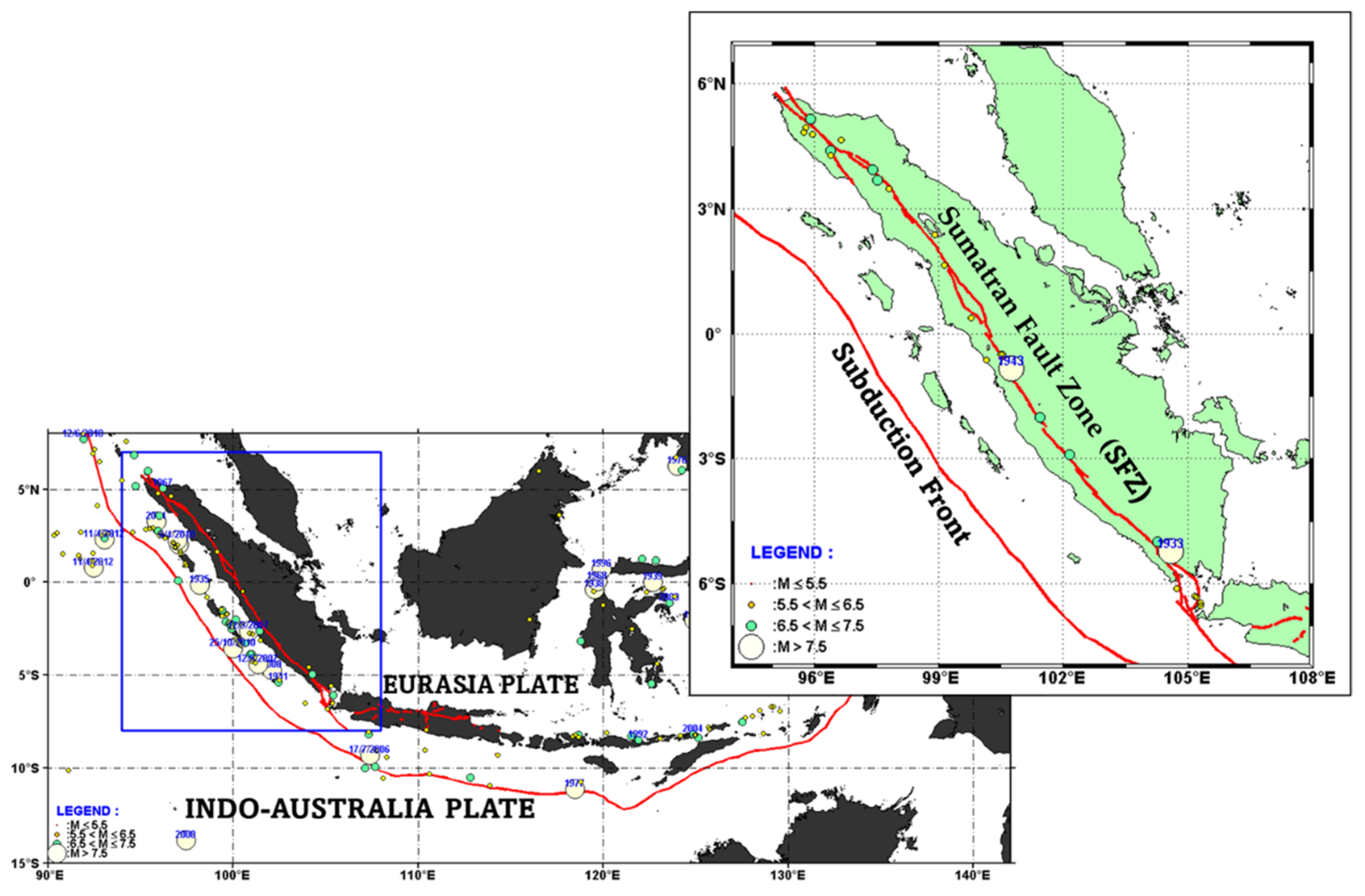
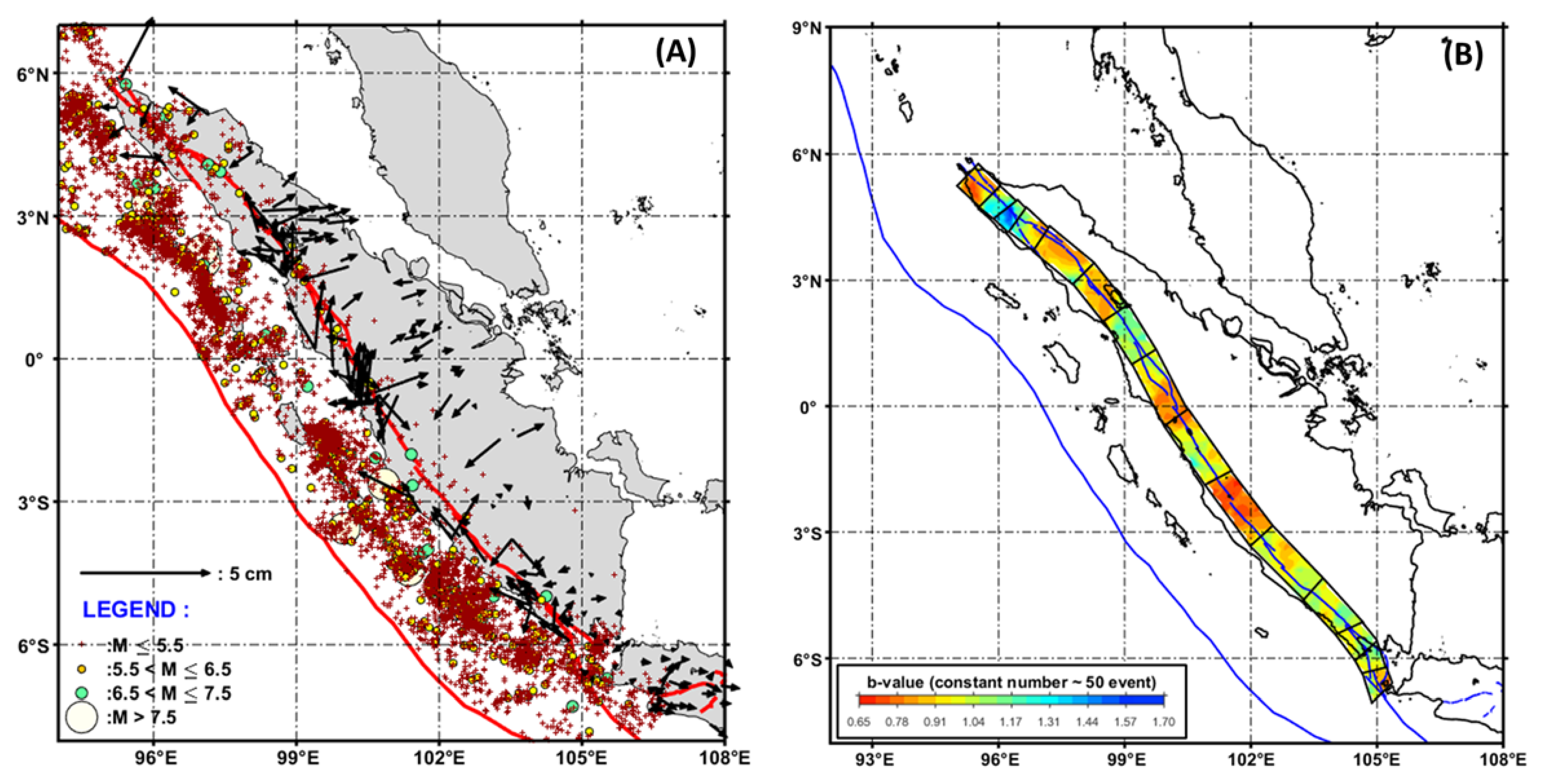
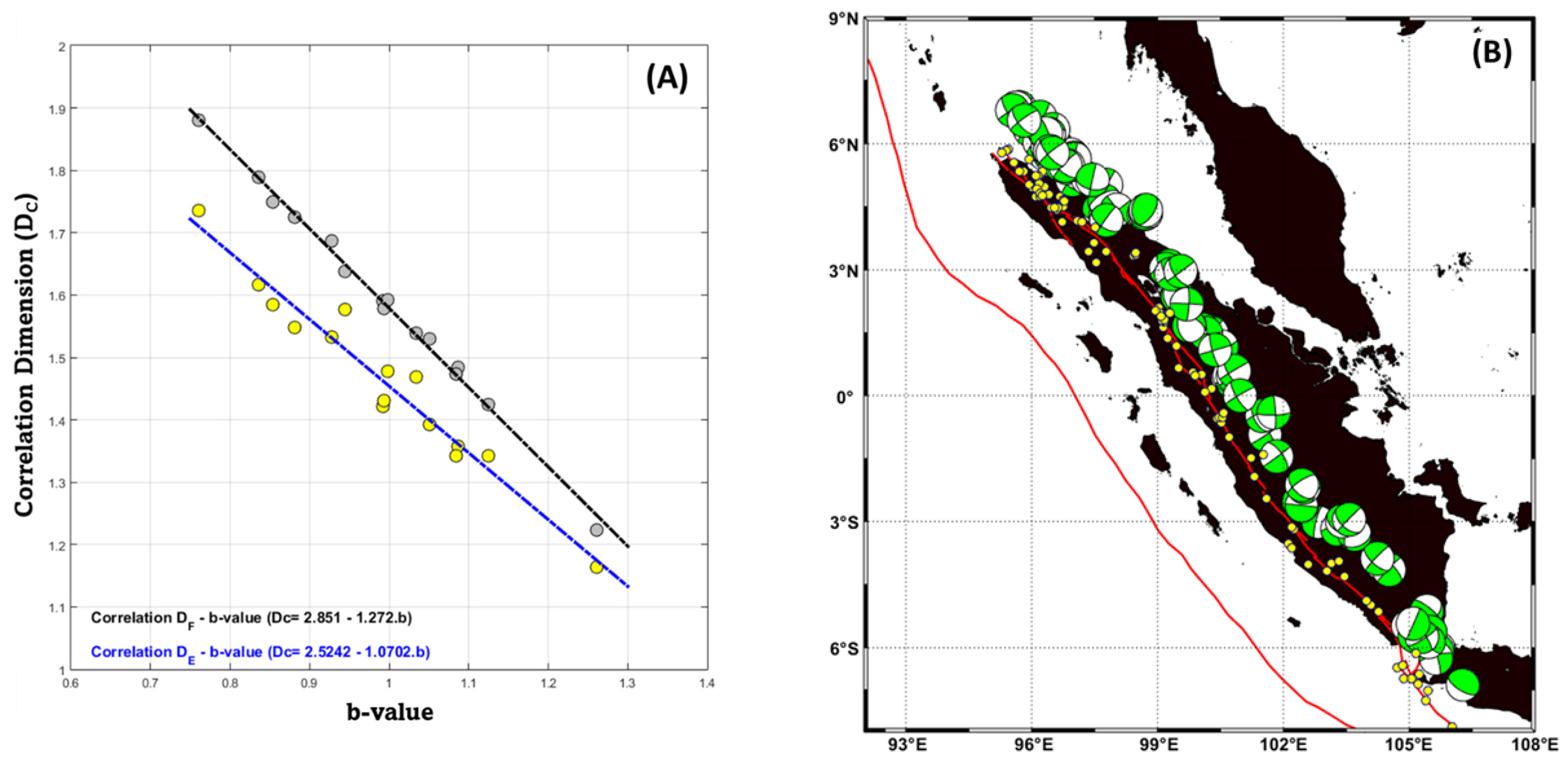
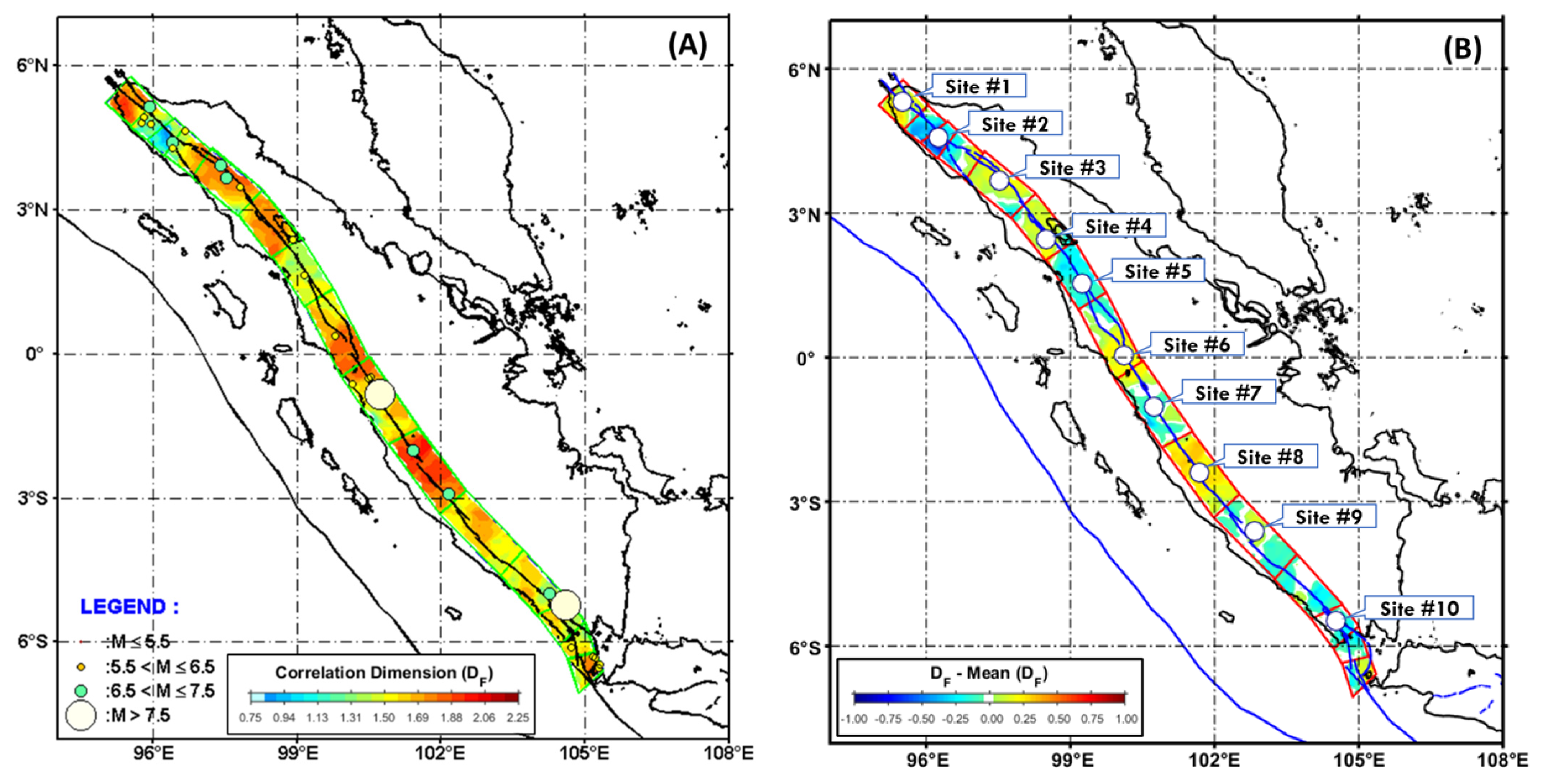

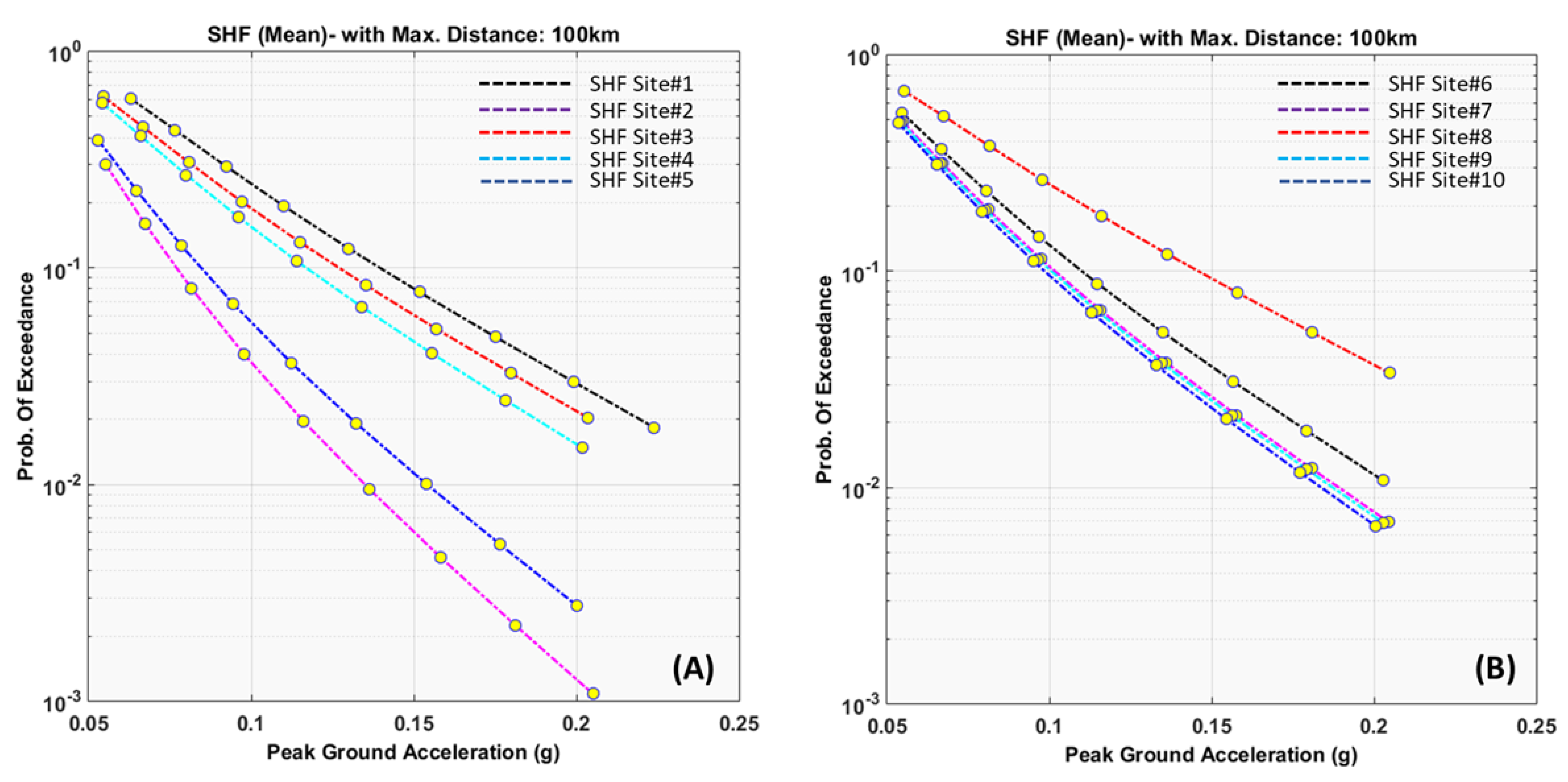
Publisher’s Note: MDPI stays neutral with regard to jurisdictional claims in published maps and institutional affiliations. |
© 2022 by the authors. Licensee MDPI, Basel, Switzerland. This article is an open access article distributed under the terms and conditions of the Creative Commons Attribution (CC BY) license (https://creativecommons.org/licenses/by/4.0/).
Share and Cite
Triyoso, W.; Sahara, D.P.; Sarsito, D.A.; Natawidjaja, D.H.; Sukmono, S. Correlation Dimension in Sumatra Island Based on Active Fault, Earthquake Data, and Estimated Horizontal Crustal Strain to Evaluate Seismic Hazard Functions (SHF). GeoHazards 2022, 3, 227-241. https://doi.org/10.3390/geohazards3020012
Triyoso W, Sahara DP, Sarsito DA, Natawidjaja DH, Sukmono S. Correlation Dimension in Sumatra Island Based on Active Fault, Earthquake Data, and Estimated Horizontal Crustal Strain to Evaluate Seismic Hazard Functions (SHF). GeoHazards. 2022; 3(2):227-241. https://doi.org/10.3390/geohazards3020012
Chicago/Turabian StyleTriyoso, Wahyu, David P. Sahara, Dina A. Sarsito, Danny H. Natawidjaja, and Sigit Sukmono. 2022. "Correlation Dimension in Sumatra Island Based on Active Fault, Earthquake Data, and Estimated Horizontal Crustal Strain to Evaluate Seismic Hazard Functions (SHF)" GeoHazards 3, no. 2: 227-241. https://doi.org/10.3390/geohazards3020012
APA StyleTriyoso, W., Sahara, D. P., Sarsito, D. A., Natawidjaja, D. H., & Sukmono, S. (2022). Correlation Dimension in Sumatra Island Based on Active Fault, Earthquake Data, and Estimated Horizontal Crustal Strain to Evaluate Seismic Hazard Functions (SHF). GeoHazards, 3(2), 227-241. https://doi.org/10.3390/geohazards3020012





